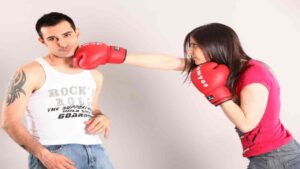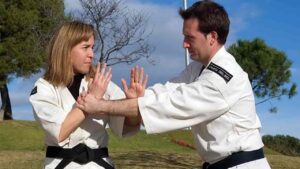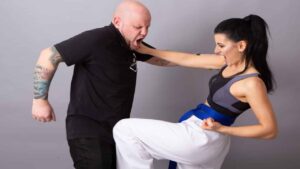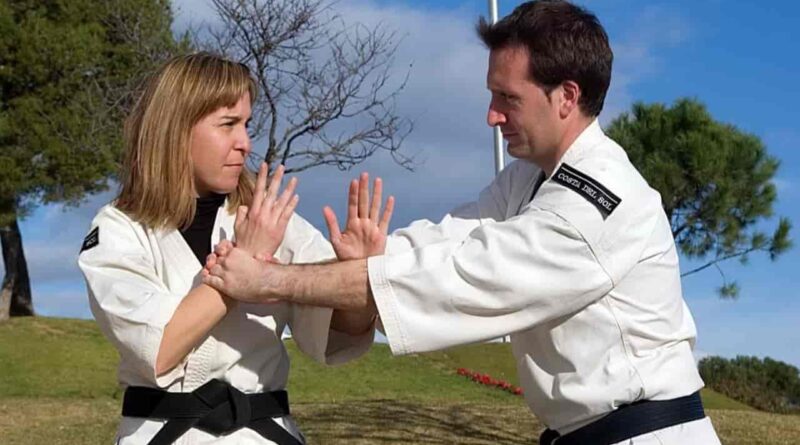Self-Defense: Exclusive 13 Effective Ways of Self Defense
Self-Defense: Exclusive 13 Effective Ways of Self Defense
How can I protect myself?
Self Defense Empowerment

Ways of self-defence
Empowerment through Awareness: 7 Effective Ways of Self Defense
Introduction
The ability to defend oneself is not just a skill but a mindset that empowers individuals to take charge of their safety. While the thought of encountering a dangerous situation can be daunting, learning self-defence techniques can significantly increase confidence and reduce vulnerability. In this article, we will explore seven effective ways of self-defence that anyone can learn and apply in times of need.
1. Self-Defense: Martial Arts for Strengthening Mind and Body
Martial arts are a time-honoured form of self-defence that offers a holistic approach to personal protection. Practices like Krav Maga, Brazilian Jiu-Jitsu, Taekwondo, and Karate focus on both physical techniques and mental discipline. Engaging in martial arts not only enhances strength, flexibility, and coordination but also cultivates mental resilience, quick thinking, and situational awareness. Regular training in martial arts equips individuals to react swiftly and effectively in threatening situations.
2.Self-Defense: Pepper Spray: A Portable and Potent Deterrent
One of the simplest yet highly effective self-defence tools is pepper spray. It is compact, easy to carry, and legal in many places. When faced with an attacker, a quick spray of this potent irritant can incapacitate them temporarily, allowing the victim to escape and seek help. Proper training on how to use pepper spray is essential, as it ensures you can use it accurately and avoid accidental harm.
3. Empowerment through Knowledge: Self-Defense Classes
Enrolling in self-defence classes is an excellent way to gain practical knowledge and skills to protect oneself. These classes are designed to simulate real-life scenarios, teaching participants how to identify potential threats, escape from holds, and counterattack effectively. Additionally, self-defence classes boost self-confidence, instil a proactive mindset, and provide a supportive community where individuals can share experiences and learn from one another.
4. The Power of Voice: Verbal Self-Defense
Often underestimated, verbal self-defence can be a powerful tool in de-escalating a potentially violent situation. Using assertive and confident language, individuals can set boundaries, demand space, and verbally deter attackers. The goal is to assert one’s willingness to defend oneself, making it clear that any further aggression will not be tolerated. Verbal self-defence allows individuals to take control of a situation before it becomes physical.

5. Utilizing Personal Safety Devices
In today’s technologically advanced world, several personal safety devices can provide an added layer of protection. From personal alarms that emit loud sounds to attract attention to wearable safety apps that alert friends or family in emergencies, these devices offer peace of mind when navigating potentially risky situations. Embracing technology in self-defence strategies can complement traditional methods and help individuals feel safer when alone or in unfamiliar environments.
6. Self-Defense: Awareness and Avoidance: The First Line of Defense
Preventing dangerous situations from arising, whenever possible, is the most effective form of self-defence. By cultivating situational awareness and recognizing potential threats early on, individuals can avoid hazardous situations altogether. This involves being mindful of surroundings, trusting instincts, and making informed decisions about personal safety. Being aware of escape routes, and well-lit areas, and avoiding isolated places can significantly reduce the likelihood of becoming a target.
7. Collaborate for Community Safety: Self-Defense:
Safety is a collective responsibility, and communities play a crucial role in ensuring the well-being of their members. Organizing neighbourhood watch programs, conducting self-defence workshops, and supporting each other in times of crisis foster a strong sense of community safety. By collaborating and looking out for one another, communities can create a safer environment for everyone to thrive.
In a world where safety cannot always be guaranteed, acquiring self-defence skills becomes essential. Empowerment through awareness, knowledge, and preparedness can significantly increase personal safety and instil confidence in facing life’s uncertainties. Whether it’s through martial arts, pepper spray, or verbal assertiveness, each method of self-defence equips individuals with the tools they need to protect themselves and others. By staying vigilant and proactive, we can create a safer and more secure world for ourselves and those around us.
Ways of self-defence
8. Self-Defense: Blending In The Art of Being Unnoticed
When it comes to self-defence, sometimes the best strategy is to avoid drawing attention to oneself. Blending in with the crowd and being inconspicuous can be a powerful defence tactic, especially in unfamiliar or potentially dangerous environments. Dressing appropriately for the surroundings and avoiding flashy or attention-grabbing behaviour can help individuals avoid becoming a target for opportunistic criminals. By appearing like just another face in the crowd, one can decrease the likelihood of attracting unwanted attention.
9. Improvised Self-Defense: Using Everyday Objects
In dire situations where traditional self-defence tools might not be readily available, the effective use of everyday objects for self-defence can be a game-changer. Items such as keys, pens, umbrellas, or even a rolled-up magazine can serve as makeshift weapons to ward off attackers. Proper training in improvised self-defence techniques is essential to use these objects safely and effectively. The ability to improvise adds another layer of preparedness, providing individuals with more options when faced with danger.
10. Self-Defense: Mental Preparedness: Developing a Strong Mindset
Self-defence is not just about physical techniques; it also involves cultivating mental strength and preparedness. Developing a strong mindset means overcoming fear and panic in stressful situations. Visualization exercises, mental rehearsals, and practising mindfulness can help individuals stay focused, think rationally, and make quick decisions under pressure. A calm and composed mind is better equipped to assess threats and respond effectively in a crisis.
11. Strength in Numbers: Buddy System
The buddy system is a simple yet effective way of enhancing personal safety. Whenever possible, avoid walking alone at night or in secluded areas. Having a trusted friend or companion can act as a deterrent to potential attackers. Additionally, in the event of an emergency, having someone else there to help or call for assistance can be invaluable. Whether jogging, going out, or travelling, having a buddy can make a significant difference in staying safe.
12. Stay Informed About Safety Resources
In today’s digital age, there is a wealth of safety information and resources available online. Knowing how to access emergency numbers, local law enforcement contacts, and safety apps can be crucial in times of distress. Stay informed about safety tips, recent crime trends in your area, and precautionary measures to avoid falling victim to common scams or threats. Knowledge is power, and being well-informed is a fundamental aspect of self-defence.
Ways of self-defence
13. Practice Self-Defense Regularly
Learning self-defence techniques is just the beginning. Regular practice is essential to maintain and refine those skills. Attend refresher courses, participate in martial arts classes, and engage in scenario-based training to keep the skills sharp. Muscle memory and quick reflexes can make all the difference in a high-stress situation. Regular practice instils confidence and ensures that self-defence becomes an instinctual response rather than a forced reaction.
In a world where personal safety can never be taken for granted, mastering the art of self-defence is a vital aspect of responsible living. Combining physical techniques, mental preparedness, and a proactive mindset empowers individuals to face potential threats with confidence. From martial arts training to utilizing everyday objects for defence, there are various ways to enhance personal safety.
Moreover, by fostering community collaboration and staying informed about safety resources, we can work together to create a safer and more secure society. Remember, self-defence is not just about physical strength; it’s about being aware, prepared, and empowered to protect oneself and others in times of need.
Safety through Self-Defense.
Title: Empowering Self-Defense: A Comprehensive Guide to Personal Safety
Introduction
Self-Defense: In an ever-changing and sometimes unpredictable world, personal safety has become a top priority for individuals of all ages and backgrounds. The ability to protect oneself from potential threats is an essential skill that can instil confidence and empower individuals to navigate the world with a sense of security.
Self-defence is not just about physical techniques; it encompasses mental preparedness, awareness, and understanding of one’s limitations. In this comprehensive guide, we will explore the concept of self-defence, its importance, and practical strategies to enhance personal safety.

The Essence of Self-Defense
Self-defence is not about promoting aggression or violence. Instead, it is a proactive approach to protect oneself from harm when faced with potentially dangerous situations. The core principle of self-defence is to use the least amount of force necessary to escape or neutralize a threat, with the ultimate goal being self-preservation. Developing a mindset of empowerment and assertiveness, rather than fear, is critical to mastering the art of self-defence.
Mental Preparedness: The First Line of Defense: Self-Defense
Before physical techniques come into play, mental preparedness lays the foundation for effective self-defence. Being aware of one’s surroundings and recognizing potential threats is crucial. Avoiding risky situations and trusting one’s instincts can prevent many confrontations altogether. The power of confident body language and a strong voice should not be underestimated, as they can deter potential attackers.
Understanding Situational Awareness
Situational awareness is a key component of self-defence. It involves staying mindful of the environment, identifying potential risks, and having a plan in mind to respond appropriately. By recognizing danger signs early on, individuals can position themselves to react swiftly and intelligently, increasing their chances of avoiding harm.
Physical Techniques for Self-Defense
While the mind plays a vital role, knowing practical physical techniques can be life-saving in dangerous situations. Self-defence training should focus on techniques that are simple, effective, and adaptable to different scenarios. Techniques such as strikes to vulnerable areas, joint locks, and escapes from grabs are fundamental skills that can be learned and practised to build muscle memory.
Self-Defense: The Importance of Regular Practice
Becoming proficient in self-defence requires consistent practice. Attending self-defence classes or workshops can provide valuable guidance and opportunities to refine techniques. Regular practice not only hones physical skills but also builds confidence, helping individuals remain calm and focused in high-pressure situations.
Empowering Vulnerable Populations
Certain individuals face higher risks, such as women, children, and the elderly. Empowering these vulnerable populations with self-defence knowledge can offer them an added layer of protection and confidence. Community-based initiatives and organizations can play a vital role in providing accessible self-defence training and support.
Digital Self-Defense in the Modern Age
As the world becomes increasingly digital, self-defence extends beyond physical encounters. Online safety is paramount in protecting oneself from cyber threats, scams, and cyberbullying. Understanding digital privacy, securing personal information, and practising responsible online behaviour are essential aspects of modern self-defence.
Conclusion
Self-defence is an invaluable life skill that goes beyond physical techniques. It is a mindset, an attitude, and a commitment to personal safety. By fostering mental preparedness, situational awareness, and practical physical skills, individuals can navigate the world with greater confidence and security. Empowered with self-defence knowledge, people can lead safer lives and inspire others to do the same, creating a society where personal safety is prioritized and valued.




